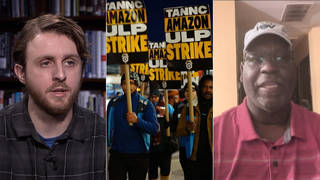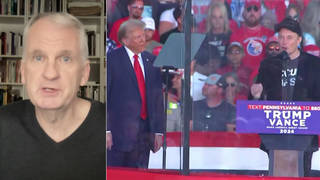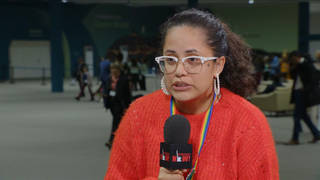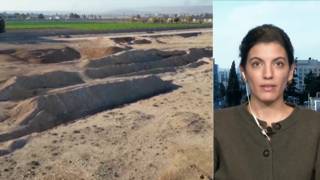
Related
We broadcast from Sweden, where the Nobel Prize will be handed out at ceremonies here in Stockholm and in Oslo. The prize is awarded in the categories of Chemistry, Physics, Medicine, Literature, Peace and Economics. They’re handed out every year on the anniversary of the death of the Nobel Prize’s founder, the Swedish industrialist Alfred Nobel, who invented dynamite. We speak with Peter Zander, the curator of the Nobel Museum. [includes rush transcript]
Transcript
AMY GOODMAN: We’re broadcasting from Sweden, the birthplace of labor activist Joe Hill and children’s author Astrid Lindgrin, the author of Pippi Longstocking
and other children’s stories. I’m Amy Goodman, as we continue today talking about the Nobel Prizes. Last night, I had the honor to join three remarkable women from around the world — Asha Hagi of Somalia, Krishnammal Jagannathan of India, and Monika Hauser of Germany — to receive the Right Livelihood Award, also known as the Alternative Nobel Prize.
Well, tomorrow the Nobel Prizes will be handed out at ceremonies here in Stockholm and also in Oslo. The prizes are awarded in the categories of chemistry, physics, medicine, literature, peace and economics. They’re handed out every year on the anniversary of the death of the Nobel Prize’s founder, the Swedish industrialist Alfred Nobel, who invented dynamite.
To talk more about the Nobel Prize, its history and its founder, I’m joined by Peter Zander, the curator of the Nobel Museum here in Stockholm.
Welcome to Democracy Now!
, Peter.
PETER ZANDER: Well, thank you.
AMY GOODMAN: It’s good to have you with us. Why don’t you tell us the story of Alfred Nobel?
PETER ZANDER: Well, the story of Alfred Nobel is, in a way, pretty short, because he did just live until the age of sixty-three, though he had time to do a lot. He was born here in Stockholm, though his father went bankrupt, and they had to move elsewhere, so they settled in St. Petersburg in Russia. So one could say that Alfred Nobel both grew up here in Stockholm and in Russia. So that was the beginning of his life.
And then he continued to be an inventor, though, from the beginning, he wanted to become an author. So literature was, I would say, one of his main interests in life.
AMY GOODMAN: But talk about how he became an extremely successful industrialist and weapons manufacturer.
PETER ZANDER: Yes, he did. And I think that was typical for its time. When he invented dynamite, which he became famous for and rich from, he said, at least himself, that he did it from a peaceful angle. He wanted it to be used to build up things. But quite rapidly, one understood it could be used for less peaceful things, as well. And he formed his own theory, one could say. He said that if each and every nation had as much dynamite as they could ever use, there would be peace on earth, which actually never worked. So, he had his own peace theory, in a way.
AMY GOODMAN: And the beginning of the whole arms industry here in Sweden in Bofors, that was really where his plants were, his factories were.
PETER ZANDER: Well, he had plants in Sweden, but also in other countries. So, to produce dynamite, for instance, you were not allowed to export it from one country to another, so he had hundreds of dynamite plants.
AMY GOODMAN: Here and in other countries.
PETER ZANDER: Here and in other countries, all over the world, from Japan in the East to the United States in the West.
AMY GOODMAN: So talk about how the idea of the prizes came to him.
PETER ZANDER: I think that he suffered a little from what people had said about him. They said that he was trading with death. And he wanted to make up. So that may be the reason why there is a peace prize. Of course, he never explained why.
But he also wanted to be remembered for building up something. So when he got older, he realized that he wasn’t going to get married. He was never ever going to have any children of his own. So the will became quite important to him, and that’s why he started to write it. And he was interested in science, he was interested in literature, and he was also interested in politics. So I suppose that’s why we have those five Nobel Prize fields, which is chemistry, physics, medicine, literature and peace.
AMY GOODMAN: And economics, how did that enter into the Nobel Prizes?
PETER ZANDER: Well, it actually never entered into the Nobel Prizes, because that was added much later. In 1968, when the Bank of Sweden had its 300-year anniversary, that was introduced. So it was given out the first time in 1969. And since it’s not financed by the Nobel Foundation, it cannot, from a technical point of view, be called a Nobel Prize. So it’s a prize in honor or in memory of Alfred Nobel.
AMY GOODMAN: Can you talk about Baroness von Suttner, the 1905 Nobel Peace Prize winner, and her influence on Alfred Nobel in setting up these prizes?
PETER ZANDER: She had a great influence. Well, all her life is almost like an operetta. Born as a countess, she was hired as a tutor in a noble family. And she fell in love with a son in that family and wasn’t allowed to stay there, because they were not supposed to marry each other.
So, the mother of that family found an ad in a daily newspaper. There were living in Vienna. So the Baroness von Suttner, or the Countess Kinsky, as her name was at the time, she was hired as the secretary of Alfred Nobel in a safe distance from Vienna. She stayed there just for a couple of weeks and went back to Vienna, though I think during those weeks she inspired Alfred about a great deal in what was an important question to her, namely peace.
And she became one of the really early leading peace activists at the turn of the century. She wrote a book called Die Waffen nieder!, or Lay Down Your Arms!. Everyone read it, even Alfred Nobel. And I know that he supported her peace campaign a lot, though they never really agreed. He actually said that “I think my dynamite might cause more peace than your struggle.” But he believed in her, anyway. So, many people say that the peace prize, the way he mentioned it in his will, is tailor-made for Baroness von Suttner.
AMY GOODMAN: And, in fact, she did win one in 1905.
PETER ZANDER: She did, in 1905.
AMY GOODMAN: Finally, this weekend, in the papers here in Stockholm was the controversy over Honeywell, the weapons manufacturer, sponsoring the Nobel Institute, Nobel Foundation. How does that relate to your museum, the Nobel Museum?
PETER ZANDER: Well, it doesn’t directly relate to the Nobel Museum, because we’re sponsored by the Swedish government and the city of Stockholm. And what we do is to bring information about the peace prize and the literature prize and all the other Nobel Prizes to the public. And so, actually, I would say, to get the best answer to that question, you should ask someone from the Nobel Foundation that knows it a lot better.
AMY GOODMAN: A controversy on the board of the foundation, some wanting to take the money and others not wanting to take it. Finally, Peter, can you talk about why all the prizes will be given here in Stockholm tomorrow night, Wednesday night, in a big ceremony, except the Peace Prize, which is in Oslo?
PETER ZANDER: I would say that’s the most common question we have at the Nobel Museum. Unfortunately, I don’t have a really quick and good answer to that, except that Alfred Nobel was pretty precise in his will that it was to take place in Oslo, or Christiania, as it was called when he wrote the will, though a good theory, I would say, is actually Baroness von Suttner, because she informed Alfred Nobel at a quite early stage that the Norwegian government, they were willing to negotiate with the Swedish government back in the 1890s, when they wanted to split a union we had back then, Norway and Sweden. That wasn’t very common at the time. Normally, you declared each other war and which was a very bad way of solving problems, according to Baroness von Suttner. And I think Alfred Nobel agreed on that. And he wanted real experts to be in each committee, so he thought politicians are responsible for war, and the real peace experts would be members of the Norwegian parliament, who pleaded for this negotiation.
AMY GOODMAN: Well, Peter Zander, I want to thank you very much for being with us. Peter Zander is one of the curators at the Nobel Museum here in Stockholm.
This is Democracy Now!, democracynow.org, the War and Peace Report.
As we continue this tale — well, the two themes here in Sweden, one following the road of peace and the other of war, of the weapons manufacturers, of Sweden being perhaps the second largest weapons exporter per capita in the world, we’ll come back with a peace activist who faces jail for her peace protest and a professor who will tell us the story.
We’re going to be going back also to New York to speak with Jeremy Scahill, author of Blackwater: The Rise of the World’s Most Powerful Mercenary Army, for the latest news on the indictments of the security guards of Blackwater involved with the Nisoor Square massacre. Stay with us.












Media Options